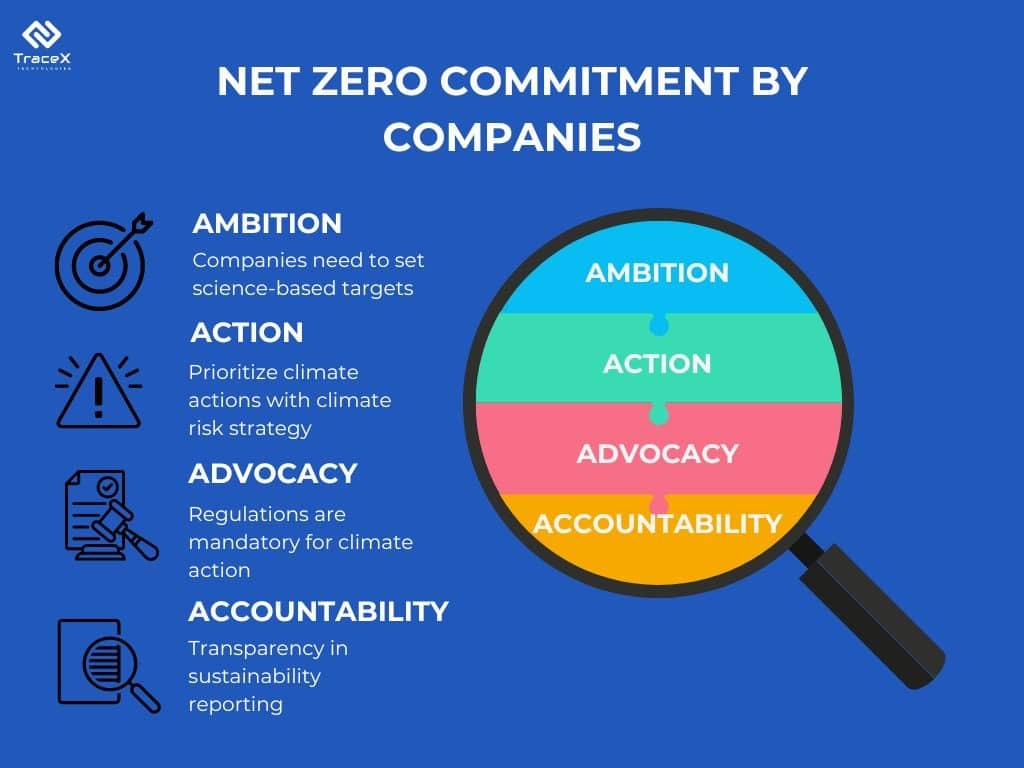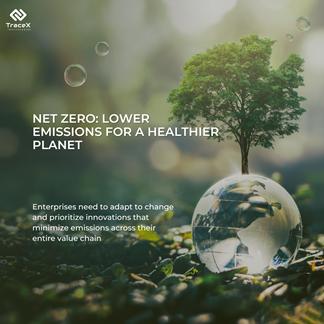Contact: +91 99725 24322 |
Menu
Menu
Quick summary: Explore effective Net Zero sustainability strategies for supply chains and discover how businesses can reduce emissions, implement renewable energy, adopt circular economy practices, and leverage technology to achieve a carbon-free future. Learn actionable steps for sustainability success in your supply chain.

Supply chains are responsible for a significant portion of global carbon emissions, with transportation, manufacturing, and sourcing accounting for a large share. As industries push toward net zero, the pressure is mounting on organizations to address the environmental impact embedded in their operations, particularly across multi-tiered, global supply chains. The business, environmental, and regulatory drivers for adopting net zero sustainability strategies are undeniable
According to recent studies, supply chains can contribute up to 70% of a company’s total emissions.
On the one hand, businesses face increasing demands from stakeholders, consumers, and investors for sustainability-driven practices. On the other hand, governments worldwide are tightening regulations, making compliance a non-negotiable. Failure to act may result in reputational damage, operational disruptions, or regulatory fines. This presents a key pain point: how can businesses transform complex supply chains into sustainable, low-carbon systems while navigating financial and operational challenges?
Key Takeaways
When we talk about net zero sustainability in supply chains, we’re referring to the goal of balancing the amount of carbon dioxide (CO2) emissions released with an equal amount of emissions removed from the atmosphere or offset by sustainable practices. In simpler terms, a net zero supply chain means that all the processes involved—whether it’s sourcing raw materials, manufacturing products, or delivering goods—produce no more carbon emissions than can be absorbed or neutralized.
To reach net zero in a supply chain, there are three key elements that need to be tackled:
A critical part of reaching net zero is measuring and managing carbon footprints across multi-tiers of the supply chain. The supply chain is often complex, with multiple layers of suppliers, manufacturers, and distributors. Each step of the process contributes to a company’s overall carbon footprint, so it’s vital to track emissions not just at the point of production, but across every link in the chain. By measuring emissions, businesses can understand where the largest impacts occur and focus their efforts where they’ll make the biggest difference.
To successfully align supply chain sustainability with net zero sustainability, businesses must adopt a multi-faceted approach. Here are several key strategies for achieving this:

The first step in any effective sustainability strategy is measuring carbon emissions. Supply chain emissions can be difficult to track because they span various stages, locations, and suppliers, but it’s essential for businesses to identify the major emission sources.
Using digital tools and platforms, such as carbon footprint calculators, traceability systems, and supply chain mapping software, can help businesses gather data on emissions throughout the supply chain and enable more informed decisions about where to focus efforts for carbon reduction.
Sourcing materials sustainably is one of the most effective ways to reduce a supply chain’s carbon footprint. Businesses can adopt sustainable procurement practices by:
Reducing the carbon intensity of manufacturing and production processes is another key element of achieving net zero sustainability in supply chains. This can be done by:
Transportation is another major source of emissions in the supply chain. Implementing sustainable transportation strategies is crucial for achieving net zero goals:
One of the most effective ways to reduce emissions and promote supply chain sustainability is by adopting circular economy principles. This involves designing systems that minimize waste, reuse materials, and recycle products at the end of their lifecycle. Businesses can:
In some cases, businesses may not be able to achieve complete carbon neutrality across their supply chains. In these situations, carbon offsetting and nature-based solutions can help to balance residual emissions. This might include investing in:

Organizations face several challenges in their journey to reach net-zero emissions.
Addressing these challenges requires a holistic approach and effective collaboration to integrate sustainability into every aspect of an organization’s operations and value chain.
Achieving net zero emissions in supply chains is a complex challenge, but technology is making it more achievable than ever. Advanced technologies such as artificial intelligence (AI), blockchain, and satellite monitoring are playing a key role in helping businesses track, reduce, and report emissions at every step of their supply chain. These tools not only improve accuracy but also streamline processes, making it easier for businesses to meet their net zero sustainability goals.
AI (Artificial Intelligence) and blockchain are two powerful technologies that are helping businesses better track and manage carbon emissions across their supply chains.
AI can analyze vast amounts of data from every corner of the supply chain, including raw materials, production processes, and transportation methods. With AI, businesses can identify emission hotspots and inefficiencies that might not be immediately apparent
Blockchain offers a decentralized and immutable record of transactions, making it an excellent tool for ensuring transparency in supply chains. When it comes to net zero sustainability, blockchain can track every step in the supply chain—from the origin of raw materials to the final delivery of a product. This allows businesses to verify their carbon reduction efforts and ensures that they are not only claiming to be sustainable but actually proving it with credible, real-time data.
Another exciting advancement in technology is satellite monitoring, which allows businesses to monitor their supply chain emissions from space. This technology is particularly helpful in tracking emissions from land use changes, such as deforestation, and monitoring sustainable agricultural practices.
For companies sourcing materials like palm oil, rubber, or soy, satellite technology helps track deforestation and land-use changes in real time. This enables businesses to ensure that their suppliers are complying with sustainable sourcing standards and that their supply chains are deforestation-free.
Monitoring agricultural emissions: Satellites can also monitor greenhouse gas emissions from agricultural activities. For businesses in the agri-food sector, satellite data can provide insights into crop emissions, water usage, and soil health, helping companies adopt more sustainable farming practices.
When it comes to achieving net zero, businesses need accurate, reliable data to measure, report, and verify their carbon emissions. Digital monitoring systems are essential tools for managing this process.
Digital MRV systems automate the process of measuring carbon emissions across the supply chain. By integrating data from various sources (e.g., transportation, production, energy consumption), these systems provide businesses with accurate insights into their emissions, allowing them to identify where reductions are needed.
MRV systems also help businesses streamline their reporting processes. These systems automatically compile data on emissions, energy usage, and other sustainability metrics, making it easier for companies to generate reports for regulators, investors, or consumers. This reduces the time spent on manual reporting and ensures that the data provided is consistent and accurate.
One of the key challenges of carbon reporting is ensuring the accuracy and integrity of the data. Digital MRV systems help businesses verify their emissions data, providing third-party auditors with access to secure, verifiable records. This ensures that businesses can confidently claim they are meeting their net zero goals and can back up their claims with reliable data.
Automation and data analytics are also crucial in the quest for net zero sustainability in supply chains. These technologies help businesses streamline their processes, reduce waste, and optimize energy use.
Automated systems can help optimize production schedules, inventory management, and energy consumption in factories and warehouses. For example, automated energy management systems can adjust heating, cooling, and lighting based on real-time data, ensuring that energy is used efficiently and emissions are minimized.
Data analytics tools help businesses identify areas where they can reduce waste and inefficiencies. For instance, by analyzing data from production lines, businesses can pinpoint where materials are being wasted and implement solutions to minimize scrap. Additionally, analyzing transportation data can help businesses optimize delivery routes to reduce fuel consumption and emissions.
The TraceX Digital MRV platform is a comprehensive solution for businesses committed to net zero sustainability. By combining blockchain and satellite monitoring, it provides a reliable, transparent, and automated way to measure, report, and verify carbon emissions. This platform is not only an essential tool for achieving carbon neutrality but also a powerful enabler of supply chain sustainability, helping businesses meet their environmental goals and stay compliant with global regulations. The TraceX Digital MRV (Measurement, Reporting, and Verification) platform is an advanced solution designed to help businesses and organizations track, measure, and report their carbon emissions and other sustainability metrics accurately
Transparent reporting and verification of net zero progress are crucial for businesses aiming to demonstrate their genuine commitment to sustainability. When companies share accurate and credible data on their emissions reductions and other environmental initiatives, they build trust with customers, regulators, and stakeholders while holding themselves accountable to meaningful climate action.
Transparent reporting allows businesses to showcase progress toward their net zero goals. By openly communicating successes, challenges, and ongoing improvements, organizations enhance their reputation and foster stronger partnerships. Importantly, transparent reporting isn’t just about showcasing good results; it’s about acknowledging where improvements are needed and being clear about the steps to address them. This authenticity is valued by customers and investors alike. To ensure consistent, accurate, and reliable reporting, businesses often turn to established sustainability frameworks and standards.
As businesses strive to meet net zero goals, technology will continue to play a critical role in achieving these targets. From AI and blockchain to satellite monitoring and digital MRV systems, these advanced tools help businesses track, measure, and reduce emissions across their supply chains with greater accuracy and efficiency.
By leveraging automation and data analytics, companies can optimize their operations, reduce waste, and make smarter decisions that support net zero sustainability. As these technologies evolve, we can expect even more innovative solutions to help businesses meet their sustainability targets while ensuring that their supply chains remain transparent, efficient, and resilient in the face of environmental challenges. The future of net zero in supply chains is powered by technology—and that future is already here.
Achieving Net Zero in supply chains involves mapping emissions, transitioning to renewable energy, implementing sustainable sourcing, adopting circular economy practices, and leveraging technologies like blockchain and AI for accurate tracking and reporting.
Technologies like blockchain, AI, IoT sensors, and Digital MRV systems provide real-time data on emissions, automate carbon reporting, ensure transparency, and optimize supply chain processes for greater efficiency, ultimately helping businesses reduce their carbon footprint.
Sustainable sourcing is crucial because it ensures that the materials and products within the supply chain are responsibly sourced, reducing environmental impacts and promoting ethical practices, which are integral to achieving Net Zero goals.
